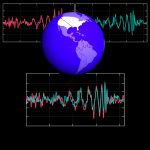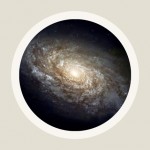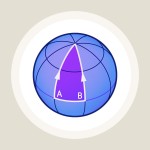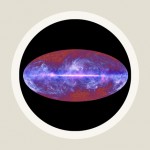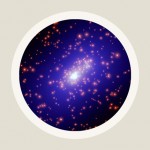Catching the wave with light
Some information on how interferometric detectors such as LIGO or GEO600 work
An article by Peter Aufmuth
Gravitational waves, disturbances in the fabric of spacetime that travel at the speed of light in a wave-like manner, are among the most fascinating predictions of general relativity. Correspondingly great is the desire to detect these waves directly. The earliest detectors were so-called resonant detectors (see the spotlight topic Small vibrations). This spotlight topic is all about today’s largest and most sensitive detectors. They are called interferometric detectors, and they have been proven to be the researcher’s best chance to detect gravitational waves.
Gravitational waves lead to rhythmic distortions of space (the simplest case can be seen in the animation on the page The rythm of geometry in the chapter Gravitational waves of Elementary Einstein). This distortion influences the time it takes a light signal to travel back and forth between two freely falling test masses. As the distance the light signal has to travel is stretched or squeezed, it takes the light a little more or a little less time to travel from one test mass to the other.
Michelson interferometers
In the early 1970, physicists realized that there is a natural way to detect these kind of changes in light travel time: interferometers of the Michelson type. Such interferometers have two orthogonal “arms”, two different paths light can travel, and they can measure the time difference between the two portions of light that travel down one or the other arm. A gravitational wave stretches one arm and simultaneously squeezes the other and thus leads exactly to the kind of difference in travel time the Michelson interferometer is designed to measure. The following image shows the basic design for an interferometer as used in a gravitational wave detector, such as GEO600:
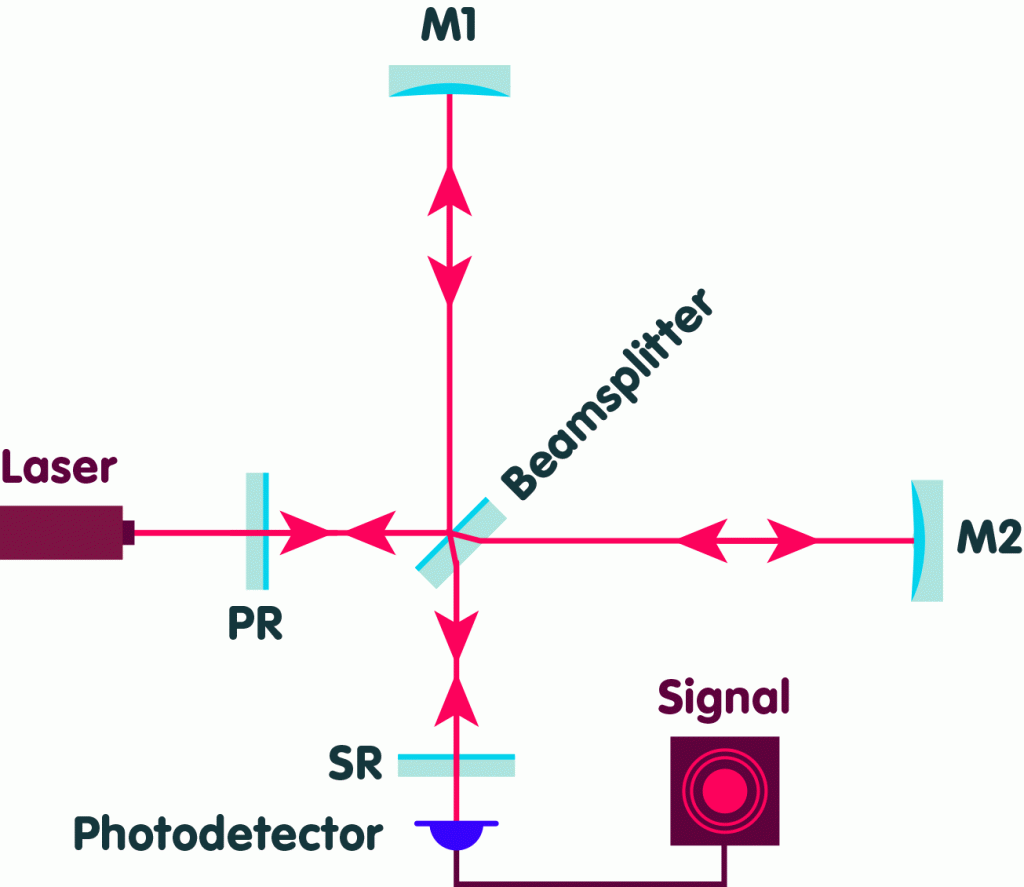
First is the light source, a type of laser developed especially for the purpose and whose frequency and intensity are highly stable. The incoming beam of laser light then reaches a beam splitter where, true to the name, it is split into two partial beams, one running up to mirror M1, one travelling on to mirror M2. At the mirrors M1/M2, the respective beams are reflected back towards the beam splitter. There, parts of the two beams travel on to the exit, below, and as those two partial beams are superimposed, interference effects result: depending on whether the wave-crests of the one beam meet up with wave-crests of the second, resulting in amplification, or whether the wave-crests of the first meet wave-troughs of the second beam, resulting in attenuation, the exit of the interferometer is either dark or bright.
Which of the two cases (or the many compromise cases in between) actually occurs depends on how long it takes a wave-crest to travel from the beam splitter to the mirror in question and back. In this way, tiniest differences in length between the two arms can lead to significant flucutations in brightness at the interferometer’s exit.
The combined partial waves that exit the interferometer are measured with the help of a photo-detector. The interferometric detector is adjusted exactly so that the light waves travelling along the two arms cancel each other out almost exactly at the exit (“destructive interference”), with wave-crests of the one in step with wave-troughs of the other. Correspondingly, the exit is almost completely dark. If a passing gravitational wave leads to changes in the arm-lengths (for instance, stretches one arm and squeezes the other), the situation changes, and the two light waves lose step. The result is a signal: an increase of brightness measured by the photodetector.
In contrast with the resonant antennas, interferometers are sensitive to the impact of gravitational waves within a large range of frequencies, more precisely: they react to waves with frequencies between 10 and 5000 Hertz. A direct consequence of this is that interferometric detectors allow the researchers to follow closely a gravitational wave signal’s evolution over time. That way, scientists can listen to the signature tunes of different types of signal, for instance to the chirping of merging neutron stars (compare the spotlight topic of the same name).
Boosting sensitivity
The sensitivity of an interferometric detector depends on the arm-length and on the power of the light inside the interferometer. Roughly: the longer the arms, the greater the power, the better. As the power of usual lasers is not nearly enough, physicists have thought of a trick to obtain greater power: With no gravitational wave present, the exit, where the photodetector is, remains dark. Of course, this doesn’t mean that the light somehow vanishes – it is simply re-distributed: one can show that, in that situation, all the light exits the interferometer travelling back from the beam splitter in the direction of the laser light source. This light can be recycled by installing the mirror PR, which reflects light trying to leave that way back into the interferometer. With this “power recycling”, the laser power within the interferometer can be increased substantially.
Another possibility to boost sensitivity is to feed that part of the light already influenced by the gravitational wave – the signal – back into the interferometer, so it is superimposed with other portions of light influenced by the wave, leading to amplification (“signal recycling”). This is the purpose of the mirror at the exit of the interferometer, denoted SR in the image above. Signal recycling is a specialty of the GEO600 detector: While this detector is shorter than its US counterparts (an arm-length of 600 metres, as opposed to 4 kilometres for the LIGO detectors), and thus is less sensitive to start with, its use of signal recycling makes up for its deficit in arm-length – at least in a certain frequency range of the gravitational waves to be measured.
There are five locations worldwidewith large interferometric detectors, ranging in arm-length from 300 and 4000 metres: The LIGO installations in Hanford, Washington and Livingston, Louisiana (US); GEO600 in Ruthe/Hannover (Germany); Virgo in Cascina close to Pisa (Italy); TAMA300 in Tokyo (Japan). (More information and links to the detectors’ websites can be found in the spotlight topic Listening posts around the globe.) The detection of gravitational waves is a cooperative effort.
The first generation of laser-interferometric detectors will reach a relative sensitivity of 10-22. In other words, for a distance of one kilometre, it is possible to detect nucleus.
Further Information
For background information on gravitational waves, check out Elementary Einstein, particularly the chapter Gravitational waves.
Related Spotlight topics on Einstein-Online can be found in the section Gravitational waves.
Colophon
is a scientist at the Albert Einstein Institute in Hannover who is involved in the maintenance and development of the gravitational wave detector GEO600.
Citation
Cite this article as:
Peter Aufmuth, “Catching the wave with light” in: Einstein Online Band 04 (2010), 01-1016



